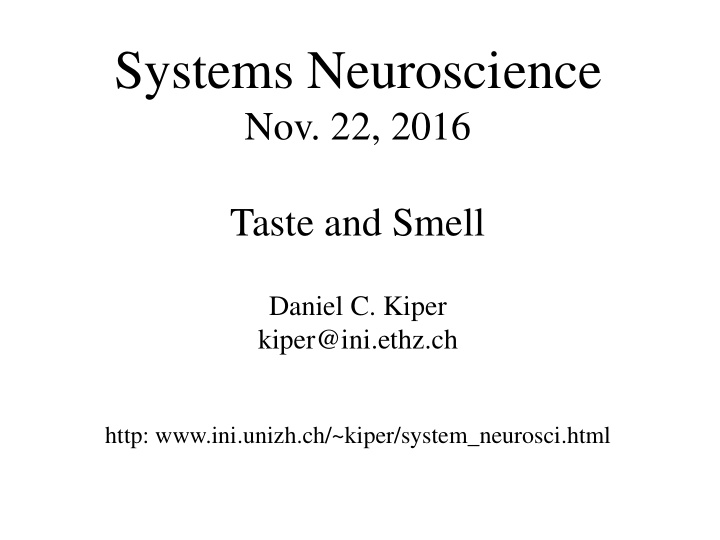



Systems Neuroscience Nov. 22, 2016 Taste and Smell Daniel C. Kiper kiper@ini.ethz.ch http: www.ini.unizh.ch/~kiper/system_neurosci.html
Brain Facts -- Taste/Smell • Average number of human taste buds = 5,000 • Number of human olfactory receptor cells = 40 million • Number of dog olfactory receptor cells = 1 billion
*Most of the tongue is *The tongue is most sensitive to all tastes sensitive to these basic tastes in certain regions
Latin for “bump”
Taste Papillae — each one has several hundred taste buds — each having 50-150 receptor cells An average person has 2000-5000 taste buds, although super-tasters have as many as 20,000. and then there are the sorry bunch who only have 500
*Post-central gyrus *Insular ctx a nucleus of the solitary tract (medulla)
Where does that gourmet flavor come from? • The color, texture, aroma, expectations, temperature, and satiety all play a role in the perception of taste along with the direct activation of the primary tastes • Smell and taste are us. Secondary to visual capture • Ill- colored food tastes, “just not right” • Lumpy mashed potatoes, soggy bacon, celery, or carrots, smoothness of grapes • Lack of smell make it difficult to distinguish a bite of an apple vs. an onion
Capsaicin • The active ingredient in spicy food • Releases substance P from certain nociceptors in the mouth • Substance P is a peptide synthesized by noci (pain) receptors that causes vasodilation and release of histamine and hyperalgesia (super sensitivity to pain) • Be forewarned about the searing pain that comes from rubbing your eyes with chili- stained (capsaicin-coated) fingers
Smell--Olfaction • We can smell and differentiate between several hundred thousand substances, only about 20% are pleasant and only ~ 16-20 are identifiable • Anosmia - Odor blindness • Women are slightly better than men in both detecting and identifying odors • The ability to detect odors declines somewhat with age • Smokers show a dulled sense of smell (they found pleasant odors to be less pleasant and unpleasant odors to be less unpleasant)
Smell--Olfaction • The olfactory system begins in the roof of the nasal cavity • Olfactory receptors are ciliated epithelial cells capable of detecting thousands of different odors • Axons from the olfactory receptors project through the cribiform plate and synapse on dendrites of mitral cells in the olfactory bulb • There is no direct projection to the thalamus • Primary olfactory cortex – ventral anterior temporal lobe (ispilateral projections fr. Ea. Nostril detect changes in odor) • Secondary cortex – lateral orbitofrontal ctx. (identifying smell)
Human - 5-6 million receptors Cat – 40 million Dog – 2 billion Olfactory epithelium a
Smell--Olfaction • Olfactory receptors continually die and regenerate in a cycle that lasts about 1-3 mos. • Mucus (snot) covers the epithelium, flows constantly & is replaced every 10 min. (contains antibodies to protect fr. Virus; provides moisture and removes foreign material from inspired air)
Transduction • Occurs in the cilia: binding of odorants – odorant binds to receptor – activates cAMP – influx of Na+ and Ca2+
Medial Dorsal Nuc.
Piriform ctx – 1 st perception of odor Orbitofrontal ctx . – conscious perception or identification of odor Limbic system – emotional, appetitive, and reproductive aspects of odor
PHEROMONES * Airborne chemicals released from animals that have a physiological or behavioral effect on another • Vomeronasal organ (VMO) – ventromedial Hyp. *While the potency may not compare to the insect system, investigators are beginning to find evidence that many mammals ranging from pigs to elephants can have a pheromone-type response to a sniff of secretions. Yes, even humans appear to respond.
PHEROMONES • McClintock Effect – synchronization of menstrual cycles in women who live together - – Cotton pads underneath the arms of donor women (8hrs.) and then wiped underneath the noses of recipient women (did not wash face for 6 hrs.) – The recipients were not told the source of the chemicals and did not consciously perceive any odors – Recipient’s menstrual cycle either shortened or lengthened • Researchers have found that female rodents share the same characteristic. Furthermore, chemicals emitted from a female rat during one part of its reproductive cycle will lengthen a fellow rodent's cycle. Chemicals from another part of the cycle will shorten the cycle.
PHEROMONES (Carlson, p. 270) • Isolated on a remote island for several weeks, a scientist notes that his beard sprouts at a pathetic rate. Back in the company of women, his whisker growth returns to a gallop. • Male moths will detect the spray of a fertile female as far as a mile away. The pheromone causes them to drop all business and meet the female for mating. • Bloodhounds have difficulty distinguishing between the smells of identical twins, but not fraternal siblings • Bruce Effect – a recently impregnated female mouse will abort fetus if encountered by a male mouse other than the one with which she mated
Synesthesia • The capacity to join sensory experiences across sensory modalities • 1:25,000 people (Cytowic, 1988) • Nabokov • Genetic component undetermined • Tasting shapes, colored hearing (speech and music have color),
Recommend
More recommend